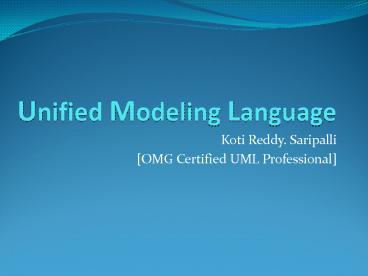Unified Modeling Language - PowerPoint PPT Presentation
1 / 24
Title:
Unified Modeling Language
Description:
Koti Reddy. Saripalli [OMG Certified UML Professional] 'Hitech City' To 'Airport' ... In 1965 the first Object Oriented (OO) programming language, Simula I, ... – PowerPoint PPT presentation
Number of Views:91
Avg rating:3.0/5.0
Title: Unified Modeling Language
1
Unified Modeling Language
- Koti Reddy. Saripalli
- OMG Certified UML Professional
2
Hitech City To Airport
3
Through Directions Text
4
Through Model Pictorial
5
How Model Matters for Software ???
6
Can U Describe This ???
7
Unified Modeling Language
- Unified Modeling Language (UML) is a standardized
general-purpose modeling language in the field of
software engineering. - Created by Grady Booch, Ivar Jacobson, and Jim
Rumbaugh. The specification itself is owned and
managed by the Object Management Group.
8
The Big Three
9
Background
- In 1965 the first Object Oriented (OO)
programming language, Simula I, was introduced. - Almost immediately interest in OO design began to
rapidly grow. This led to the emergence of
numerous competing OO design methods. - By the early 90s there were 50 OO design
languages. - Top 3 Modeling Languages (Each one had Pros
Cons) - OOAD Object Oriented Analysis Design - Grady
Booch, - OMT Object Management Techinque James
Rumbaugh - OSE Object Oriented Software Engineering Ivar
Jacobson
10
Unified Modeling Language
- OOAD Grady Booch
- Very Complex, Efficient for low level design,
Good at design weak at Analysis - OMT Ivar Jacobson
- Simple, Good for high level design, Good at
analysis, weak at design. - OOSE James Rumbaugh
- Major feature is Use Classes, viewing the
design from user perspective. - UML
- Booch, Jacob, Rumbaugh, joined hands together in
creation of new modeling language by
consolidating their individual ones. - Called the creation as Unified Modeling Language.
- Analysis refers to understanding the problem,
Design refers to illustrating solution.
11
UML Timeline
12
UML Diagrams
- Behavioral
- behavioral features of a system / business
process - Use Case Diagram
- Activity Diagram
- State Machine Diagram
- Structural
- element of spec. irrespective of time
- Class Diagram
- Component Diagram
- Deployment Diagram
- Interaction
- emphasize object interaction
- Communication(collaboration)
- Sequence
13
Class Diagrams - Intro
- Show the classes of the system, their
inter-relationships, and the operations and
attributes of the classes - Things to look for
- Members
- Data Member (s)
- Method Member (s)
- Association (s)
- Visibility
- Protected
- Public
- - Private
14
Class Diagrams - Associations
- Aggregation Employee contains the reference of
Division, Thought Employee object dead, Division
object can still alive. (Part-Of) - Composition Car contains reference of Wheel,
Wheel dies along with the car (Has-a). - Association one type is using another type
Aggregation or Composition are one type of
association. And also if a type method uses
another type as parameter or return value like - public Employee GetEmp(int id)
15
Class Diagrams - Advanced
- Interfaces Interfaces are represented as classes
but with a stereo type attached. - Inheritance
- Generalization Parent Type.
- Specialization Child Type
16
Object Diagram
- Class Diagram Show the classes of the system,
their inter-relationships, and the operations and
attributes of the classes. But not the runtime
version of these. - A pictorial representation of the relationships
between these instantiated classes at any point
of time (called objects) is called an "Object
diagram."
17
Sequence Diagrams
- Is a behavioural diagram, focus on time ordering
of messages (where a message is nothing but a
method call) in given task. - Ingridients
- X axis
- Y axis
- Objects
- Life Line
- Method Calls along with Time
- First Diagram
18
Activity Diagrams
- A graphical representation of how data move
around an information system. This is a
behavioral diagram.
19
Component Diagrams
- Describe software components and their
dependencies to each other. This is a structural
diagram. - Package will show the packaging of these
components. - In .net, package is called Assembly.
20
Deployment Diagrams
- A deployment diagram shows the configuration of
run time processing nodes and the components that
live on them.
21
Collaboration Diagram
- Collaboration Diagrams are used to model the
interactions between classes in the object
model. Collaboration diagrams are also known as
Object Message diagrams.
22
State Machiene Diagrams
- State diagrams (also called State Chart diagrams)
are used to help the developer better understand
any complex/unusual functionalities or business
flows of specialized areas of the system
23
Usecase Diagrams
- Use cases to capture the intended behaviour of
the system you are developing, without having to
specify how that behaviour is implemented. Use
cases provide a way for your developers to come
to a common understanding with your system's end
users and domain experts. - Consists Actors, Use cases, Include and extended.
24
Q A






























